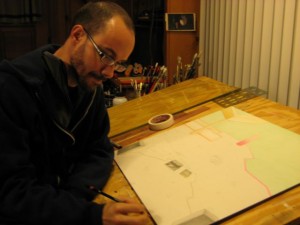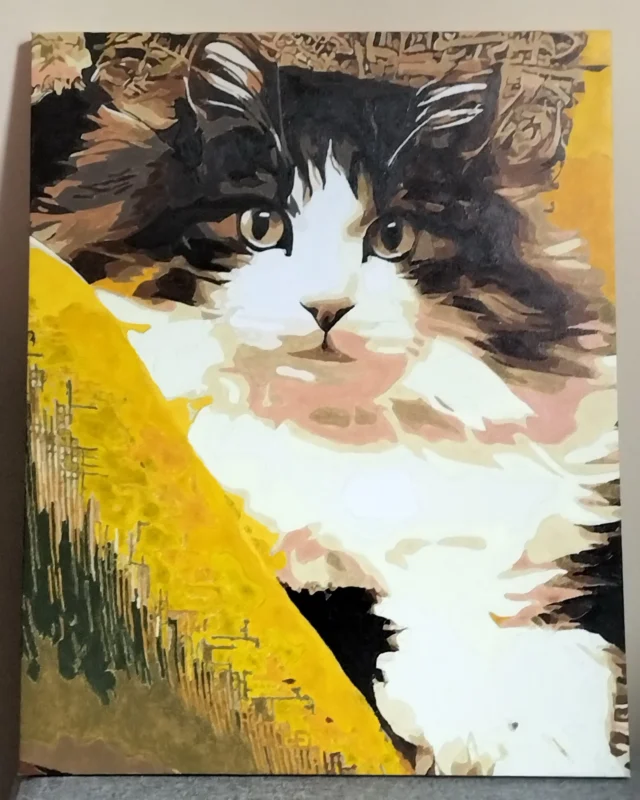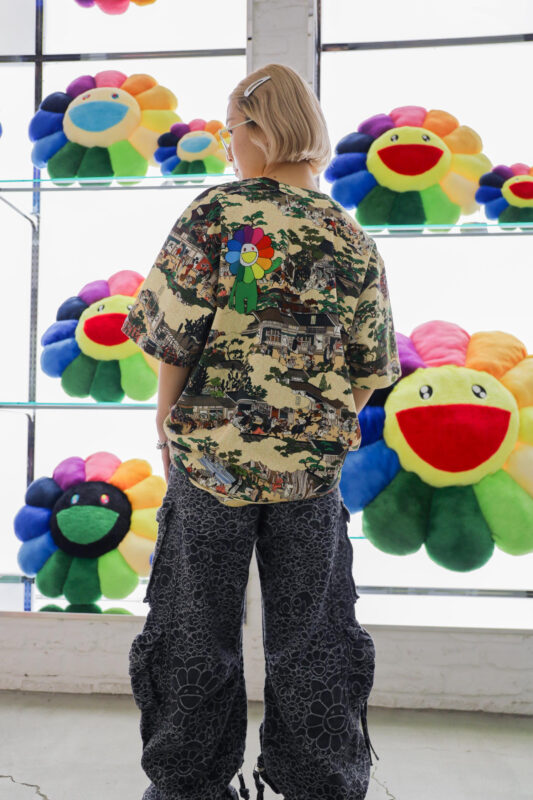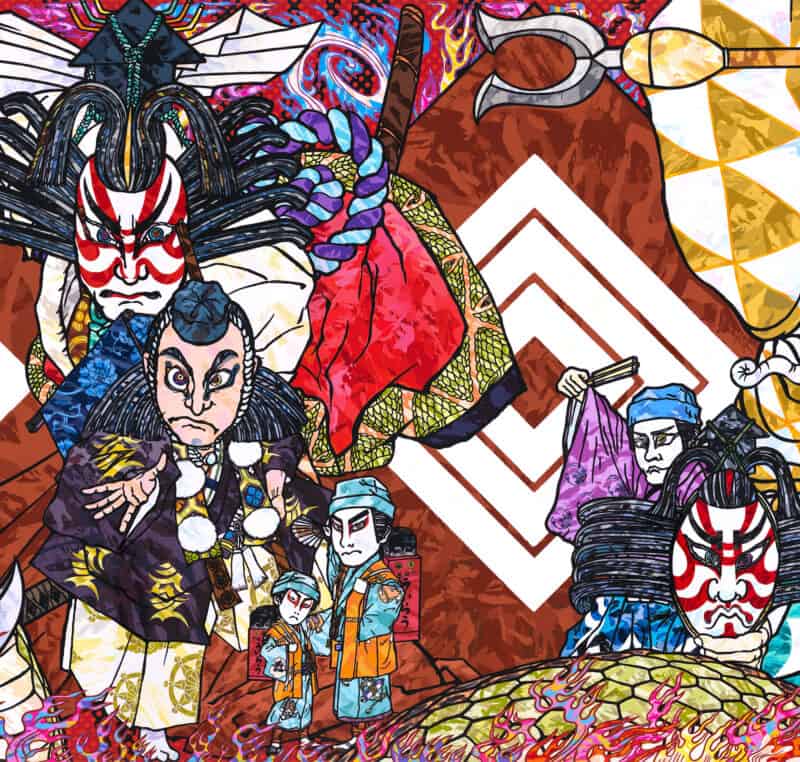
With thanks to Bill at www.inkstainedhands.com
1. One thing that strikes me while looking at your recent work is the sense of deep space. Many artists dealing with new urban spaces, alienation, disruption, and entropy also create spaces that feel either claustrophobic, flat, or unnatural, but you deal with these topics and have decidedly convincing deep pictorial spaces. What does the space in your images mean to you?
I think at some level I like to create contradictions within my work and try to sort out a balance in the making. My interest in creating deep space and putting it up against areas of flat color is an example of that process. My training when I was a student really focused on perspective and composition; I was lucky to study with some real masters. And I think I’m still using the tools I learned there but also playing with them, trying to turn them a little bit on their head.
2. There are beautiful moments of color in your images, do they have a significance to you?
Color is very important to my work and I employ it in many different ways even within each piece. At one level, I’m generating these images that are kind of grim and color is one way to engage with my audience, to lure them in, like those deep sea fish with the glowing nubbin’. I also hope that by employing a kind of pop pallet I will create some critical inquiry into the relationship between color and content both in terms of the work’s relationship to other art in the world but also
to our relationship to the scenes depicted in the work.
2a. When we met 8 years ago you were in the printmaking program at the University of Iowa, and you were making very technically precise prints. When I look at your paintings I see moments of color that might be from Japanese woodblock prints, and there is also moments of tension between something I identify as a painter’s hand and a print maker’s hand. How has your training as a print maker influenced your painting?
This is a very astute observation, Bill. My time spent making prints has definitely influenced my paintings. I am very interested in the interplay between the hand-made painted or autographic mark of a brush or pencil and graphic printed mark. In many of my paintings I actually use stencils and roller or brayer to create flats of color that have no obvious brush strokes. I like to think that the tension and contradiction these types of marks generate when in conversation with each other in the image informs the content of the work.
3. How do you gather imagery to use?
I spend a lot of time collection, sorting and messing-with my source material. Where it comes from seems very important to the final product. For the past few years I’ve been narrowing my source material to just documentary sources, focusing first just on images take from the Sunday edition of the New York Times, but lately opening it up to other online news sources and photo-blogs that present information from first-hand sources (like soldier’s or civilian blogs in Iraq or Afghanistan or NGO websites in Africa). This material is cut out of the paper or printed in black and white from the site and collected on a daily or weekly basis.
Then I sort though it all and try to notice patterns in the architecture or terrain and also examples colloquial daily urban habit. It’s a kind of pyscho-geographic divination. For example, I might just focus on the skyline of an image or just the blast walls, on other occasions white plastic lawn furniture or street flags might strike me as crazy ornamentation for a refugee camp. Basically, I’m interested in how strife, climate change, disasters and global migration effect the way folks live and the types of environments they build.
I sort of put news into a juicer and little useful bits that survive the editing process and come out the other side. These bits are incorporated into mental combinations or collages that form my final compositions. A skyline from here + a shipping container from there + rubble from that footage.. etc. etc. until it looks ‘right’.
4. Can you talk about what you think are some interesting trends in contemporary art?
I’m not sure I can identify any trends at the moment. I was tracking deer and sailing ships for a while but since then I’ve sort of stopped following it
all so closely. There’s a lot of art out there right now, and I’m very curious to see what the economic down-turn is going to do to our ability to
put the work in front of an audience.
6. What is the first gallery you go to when you visit New York? Do you prefer The Met or The Moma?
I usually head to Jeff Bailey or Morgan Lehman, I think they have a good eye and I like the scale of their spaces. Some of the giant spaces overwhelm and feel like something unachievable to a mere mortal. Or at least a mortal with a studio as small as mine. If I’m looking to be overwhelmed I’ll go to the Met. I love that place and it’s easy to spend all day. The MOMA is fun but the collection at the Met can always show you something unexpected and exceptional.
7. Favorite bookstore?
I love bookstores. Often times I find a good bookstore more generative than a trip to Chelsea.
Some of my favorites: St. Marks Bookshop, Spoonbill and Sugartown in Brooklyn, Prairie Lights in Iowa City.
8. Favorite Zine?
I have a Zine/Magazine problem that I’ve been trying to cut back on.. I think it’s my love of printed material and ephemera keeps me going back for more.
At the moment I’ve been very excited about just about anything to come out of Picture Box in Brooklyn. And Although I never actually finish reading it, I think
The Believer is a very beautiful magazine to look at. The colors and layout are always sublime.
9. What book have you read that influenced the way you behave in the studio?
These days it seems I’m reading mostly Comics, Poetry and Sci-fi.
After hearing a lot about it, I finally started reading Charles Reznikoff’s Testimony. That has really altered the way I think about source material. And I read a lot (during the semester it’s usually audio books in the studio), at one level this is part of my overall process. I use found text from whatever I’m reading, it is recycled into titles or notes in my sketch book. Some authors have been especially fruitful in that regard are Haruki Murakami, Octavia Butler and William Gibson. Recently, Alex Ross’s book The Rest is Noise has really captured my attention. On the comics front I’ve had an art crush on Anders Nilsen for a while, that is still holding steady with amazing Big Questions series published by Drawn and Quarterly. So good. And Fun Home by Allison Bechdel was really an amazing read.. and Rotu Modan’s Exit Wounds is really great.. and lastly, DMZ by Brian Wood seems really prescient at the moment.
For me, critical or art theory is most rewarding when read in a group, and since I lack a study group at the moment, I’ve been more inclined to find works that push the same issues but embed within a creative work of poetry or fiction; the works of Joan Retallack, Javiar Marias, Jena Osman, Jose Saramago and Thalia Field are good examples of this.
10. There is something depressing and rugged about your imagery, but on the other hand there is something beautiful and precise, how do you reconcile these two sides of your work? Does the way you make marks signify something?
That is a great and concise summation of the aesthetic destination I’m interested in arriving at. As I said earlier I can’t help but embody contradictions in the work and at some core level I’m interested in making work that speaks about what I see happening in the world but I’m also interested in making things that have precision and beauty. A good example might be Barbara Kruger, her work is a very powerful critique of advertising, stereotypes and the ad men of Madison Avenue, but she seems to be using the same tools as those she is critiquing . When her billboard works were first made they spoke to that time and those issues, I feel like in this moment we are so inundated with images on the web and TV that we become numb to it. I am more interested in trying to make a subtle statement which creates a complex relationship between plot and narrative or form and content.
now updated near-weekly!
Since 2008, the thinking person’s favorite online resource for interesting printmaking miscellany…






